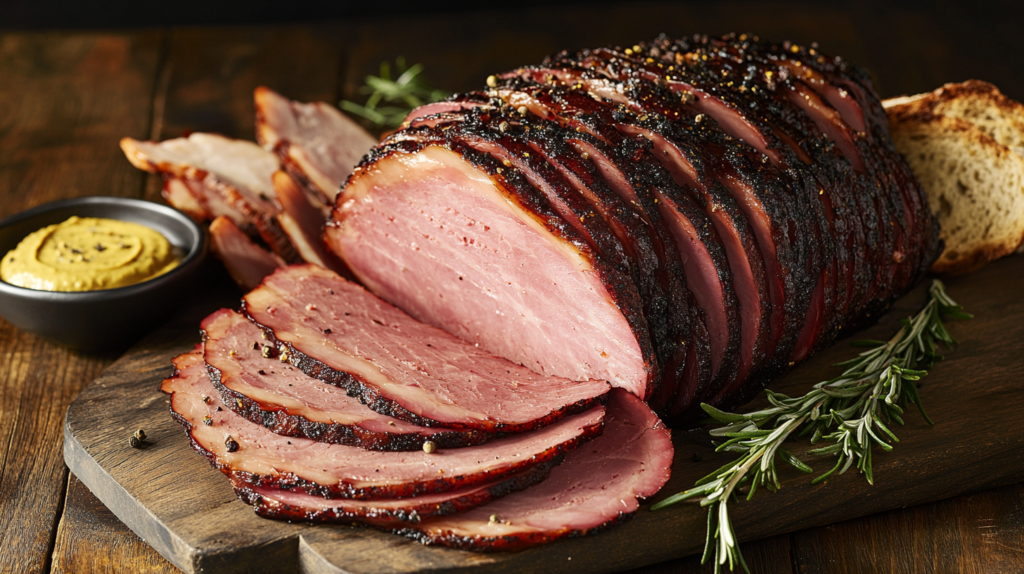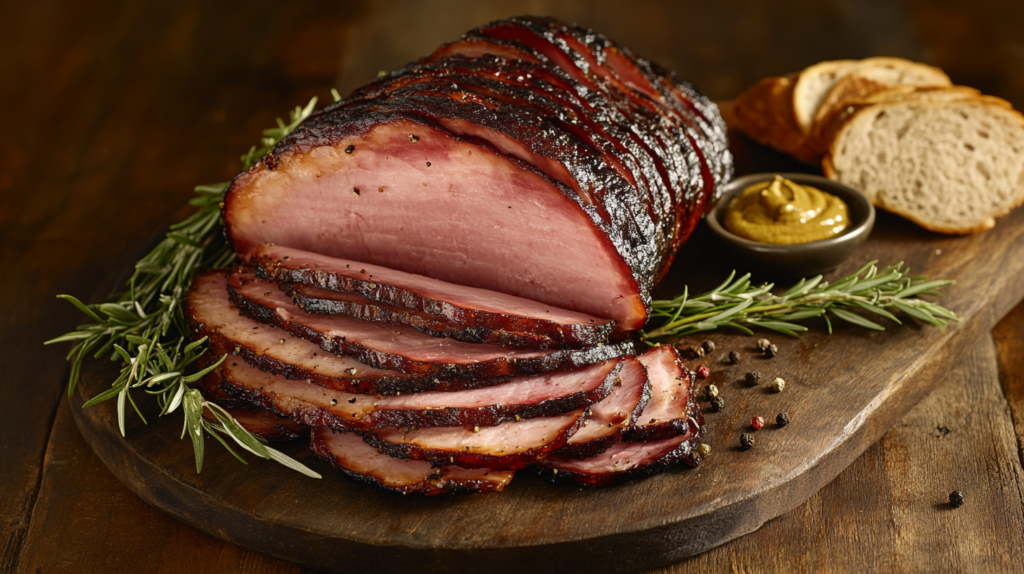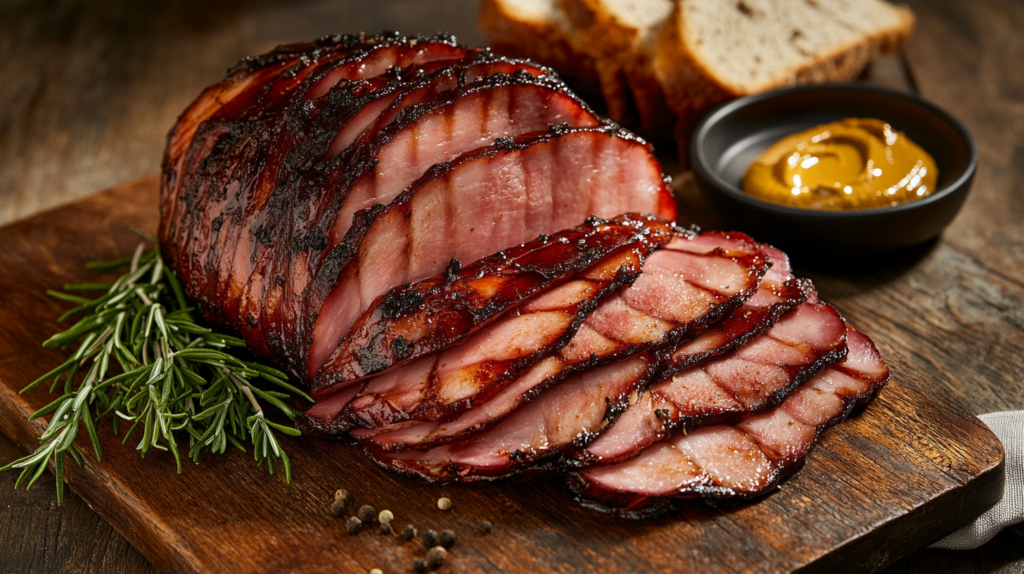Introduction to Black Forest Ham
Black Forest ham is a world-renowned delicacy originating from the Black Foreste region of Germany. Renowned for its rich, smoky flavor and distinctive dark rind, artisans craft this ham using a meticulous curing and smoking process that dates back centuries. Its unique flavor profile, characterized by subtle hints of spices and a deep smokiness, has made it a staple in German cuisine and a popular choice worldwide.
Origins of Black Forest Ham
The tradition of making Bf ham, or Schwarzwälder Schinken, began in the Black Foreste region of southwestern Germany, an area known for its dense forests and artisanal food practices. People originally cured and smoked the ham to preserve it during the cold months. They used local woods like fir and juniper in the smoking process, which imparted a signature flavor that distinguishes it from other cured meats.
Unique Flavor Profile
What sets Black Forest ham apart is its complex yet balanced taste. The flavor is achieved through:
- Curing: A dry rub of salt, garlic, coriander, and other spices is applied, allowing the ham to cure for several weeks.
- Smoking: The ham is cold-smoked using woods like fir and juniper, giving it a rich, smoky aroma and a characteristic dark, almost black rind.
- Aging: It is aged to develop a tender texture and deepen its flavor, resulting in a product that is both savory and aromatic.
The combination of these steps creates a ham with a perfect balance of smoky, salty, and slightly sweet flavors.
Widespread Appeal
Black Forest ham’s versatility and exceptional taste have earned it widespread appeal. It is commonly enjoyed in:
- Traditional German Dishes: Used in recipes like ham and cheese pretzels or potato salads.
- Breakfast and Sandwiches: Perfect for adding flavor to omelets, bagels, or paninis.
- Charcuterie Boards: A standout component on meat and cheese platters.
Whether chefs serve it thinly sliced as a snack or use it as the centerpiece of a dish, Black Forest ham captivates food enthusiasts across the globe by blending time-honored traditions with culinary versatility.
What is Black Forest Ham?
B F ham, or Schwarzwälder Schinken in German, is a traditional smoked and cured ham originating from the Black Forest region of Germany. Renowned for its deep smoky flavor, tender texture, and characteristic dark rind, this ham is a culinary staple that has gained global recognition for its quality and taste.
Distinctive Characteristics
Black F ham stands out due to its unique preparation process and visual appeal. Key features include:
- Dark, Smoky Rind:
- The outer layer is darkened through cold smoking, giving the ham its signature appearance.
- Rich Flavor Profile:
- It boasts a deep smoky flavor complemented by hints of spices like garlic, coriander, and juniper.
- Tender Texture:
- The ham is aged after smoking, resulting in a tender yet slightly firm bite.
- Thin Slices:
- Typically served thinly sliced, Black Forest ham’s texture and flavor are best appreciated in delicate portions.
What Sets It Apart from Other Types of Ham
Black F ham differs from other types of ham in several ways:
- Smoking Method:
- Unlike honey-baked or glazed hams, Black Forest ham undergoes cold smoking using specific woods like fir or juniper, imparting its unique flavor.
- Dry Curing:
- It is dry-cured with a mixture of salt, spices, and herbs, as opposed to wet curing or brining used in many other hams.
- Traditional Craftsmanship:
- Its production adheres to centuries-old techniques from the Black Forest region, giving it an authentic and artisanal quality.
- Appearance:
- The almost-black rind and reddish-pink interior make it visually distinct from lighter-colored hams like Virginia or Parma ham.

B Forest ham’s meticulous preparation process and complex flavor profile set it apart as a premium product, celebrated for its tradition and versatility in a variety of culinary applications.
How Black Forest Ham is Made
Producers craft Black F ham using time-honored techniques that ensure its rich flavor and distinctive appearance.The process includes curing, seasoning, smoking, and aging, each step contributing to the ham’s unique taste and texture. Below is a step-by-step explanation of how this traditional delicacy is made.
1: Selection of the Ham
- The process begins with high-quality cuts of pork, typically from the hind leg. The meat must meet strict standards to ensure tenderness and flavor.
2: Curing
- Dry Rub:
- The ham is coated in a dry rub made of salt, garlic, coriander, juniper berries, and other spices. This mixture infuses the meat with flavor while preserving it.
- Curing Period:
- The ham is left to cure for several weeks, allowing the spices to penetrate deeply. This step also helps draw out moisture, concentrating the flavor.
3: Seasoning
- After curing, additional spices and herbs may be applied to enhance the flavor profile. This seasoning ensures the ham has a balanced, aromatic taste.
4: Smoking
- Cold Smoking:
- Producers cold-smoke the ham at low temperatures using wood from local trees, such as fir or juniper. This step imparts a deep, smoky aroma and creates the ham’s signature dark, almost black rind.
- Duration:
- The smoking process lasts several days to weeks, depending on the desired intensity of flavor.
5: Aging
- Once smoked, the ham is aged in a cool, controlled environment. Aging enhances the ham’s tenderness and allows the flavors to develop fully. This step can take several weeks to months.
Final Product
- After aging, producers slice the ham thinly to showcase its reddish-pink interior, framed by the dark rind. The finished product boasts a complex flavor that is smoky, salty, and subtly sweet.
The meticulous process of making Black F ham preserves centuries-old traditions while delivering a product that is both rich in flavor and visually striking. This attention to detail is what makes Black F ham a prized delicacy worldwide.
Authentic vs. Imitation Black Forest Ham
Black F ham is famous for its rich flavor and traditional craftsmanship. However, not all hams labeled as “Black Forest” meet the strict standards of authenticity. Understanding the differences between authentic and imitation versions can help you choose the highest-quality product.
Differences Between Traditional and Mass-Produced Versions
- Production Method:
- Authentic Black Forest Ham: Made using time-honored techniques, including dry curing, cold smoking, and aging. The process can take several weeks to months, ensuring a complex flavor profile.
- Imitation Ham: Often wet-cured with brine and liquid smoke for faster production. These shortcuts result in less depth of flavor.
- Ingredients:
- Authentic: Uses natural ingredients like salt, garlic, juniper berries, and coriander for seasoning, along with wood smoke from fir or juniper.
- Imitation: May rely on artificial flavorings, pre-mixed brines, and smoke flavoring to replicate the taste.
- Texture and Appearance:
- Authentic: The texture is firm yet tender, with a dark, smoky rind and a reddish-pink interior.
- Imitation: Often softer due to brining and lacks the distinct dark rind characteristic of authentic Black Forest ham.
How to Identify Authentic Black Forest Ham
- Protected Geographical Indication (PGI):
- Look for PGI labeling, which indicates that producers craft the ham in Germany’s Black Forest region using traditional methods.
- Ingredients and Process:
- Check the label for natural curing ingredients and wood-smoked preparation. Avoid products with artificial flavorings or liquid smoke.
- Visual Cues:
- Authentic Black Forest ham has a nearly black rind from cold smoking, while imitations may have a lighter or uniform color.
- Flavor and Aroma:
- Authentic ham has a balanced flavor with a pronounced smoky aroma and subtle hints of the spices used in the curing process.
Choosing authentic Black F ham ensures you enjoy the rich traditions, complex flavors, and superior quality that make this delicacy a culinary treasure.
Cheeses That Complement Black Forest Ham
Black Forest ham’s rich, smoky flavor pairs beautifully with a variety of cheeses, enhancing its savory profile. Whether creating a sandwich, charcuterie board, or baked dish, selecting the right cheese can elevate your culinary creation. Here are some top cheese pairings for Black F ham:
1. Swiss Cheese
- Why It Works:
The mild, nutty flavor of Swiss cheese complements the smoky richness of Black Forest ham without overpowering it. - Best Use:
Ideal for sandwiches, croissants, or grilled paninis.
2. Gouda
- Why It Works:
Gouda, especially smoked Gouda, echoes the smoky notes of the ham while adding a creamy texture and subtle sweetness. - Best Use:
Perfect for charcuterie boards or melted in casseroles and quiches.
3. Cheddar
- Why It Works:
Sharp cheddar provides a bold, tangy contrast to the ham’s saltiness, creating a balanced and flavorful pairing. - Best Use:
Great for ham and cheese sliders or layered in baked mac and cheese.
4. Brie
- Why It Works:
The creamy, buttery texture of Brie adds a luxurious element, balancing the smoky ham with its mild richness. - Best Use:
Excellent in sandwiches or served with crackers and fruit on a charcuterie platter.
5. Havarti
- Why It Works:
Havarti’s smooth, buttery flavor complements the savory profile of Black Forest ham while offering a subtle hint of sweetness. - Best Use:
Use in wraps, flatbreads, or as part of a breakfast sandwich.
6. Provolone
- Why It Works:
Provolone’s mild, slightly tangy taste enhances the smoky notes of the ham without overshadowing it. - Best Use:
Perfect for melts, pizza toppings, or ham and cheese rolls.
When pairing cheeses with Black Forest ham, consider the balance of flavors and textures. The right cheese will not only complement the ham’s smokiness but also add a delightful dimension to your dish.

FAQs About Black Forest Ham
Here are answers to some frequently asked questions about Black F ham, covering everything from its preparation to its uses and storage.
1. What is Black Forest ham?
Black F ham, a traditional German cured meat from the Black F region, undergoes dry-curing, cold-smoking, and aging, which create its smoky flavor and dark rind.
2. Is Black Forest ham cooked or raw?
Producers prepare traditional Black F ham by cold-smoking and aging it, rather than cooking, making it ready to eat. People typically slice it thin and enjoy it without additional cooking.
3. How does Black Forest ham differ from other hams?
Black F ham is unique for its cold smoking process, which imparts a deep, smoky flavor. It also features a signature dark rind and a more complex taste compared to wet-cured or honey-glazed hams.
4. How should I store Black Forest ham?
Unopened, store Black F ham in the refrigerator. Once opened, wrap it tightly in plastic wrap or aluminum foil and keep it refrigerated. It’s best consumed within 3–5 days of opening.
5. Can I freeze Black Forest ham?
Yes, Black F ham can be frozen. Wrap it tightly in freezer-safe packaging and store it for up to 2 months. Thaw it in the refrigerator before use to maintain its texture and flavor.
6. What are the best ways to enjoy Black Forest ham?
Black F ham is incredibly versatile. You can:
- Add it to sandwiches or wraps.
- Serve it on a charcuterie board with cheeses and fruits.
- Incorporate it into breakfast dishes like omelets or quiches.
7. Is Black Forest ham gluten-free?
Yes, authentic Black F ham is naturally gluten-free because producers make it using pork, salt, spices, and natural smoke. However, always check the packaging for additional ingredients in mass-produced versions.
8. How can I identify authentic Black Forest ham?
Look for a Protected Geographical Indication (PGI) label, which ensures producers crafted the ham in the Black F region using traditional methods. Authentic Black F ham will also have a dark rind and a pronounced smoky flavor.
Pair with Classic German Dishes
Include Black F ham in your culinary adventures with traditional recipes like German potato salad for an authentic touch.
Enhance Sandwich Recipes
Elevate your sandwiches by pairing Black Forest ham with ideas inspired by this mortadella sandwich guide.
Perfect for Charcuterie Boards
Explore how Black Forest ham can complement other cured meats on a board alongside quesillo dessert for a mix of savory and sweet.
Pair with Breakfast Favorites
Add slices of Black Forest ham to your breakfast dishes, much like the smoky addition to smoked chicken drumsticks.
Try in Pasta Creations
Incorporate Black Forest ham into pasta dishes, taking inspiration from this linguini recipe.
Use in Fusion Dishes
Experiment with Black Forest ham in fusion recipes, inspired by the versatile flavors of langostino seafood dishes.
Create Unique Snacks
Slice Black Forest ham into crispitos-style rolls, much like the creative snacking ideas in this crispitos guide.



